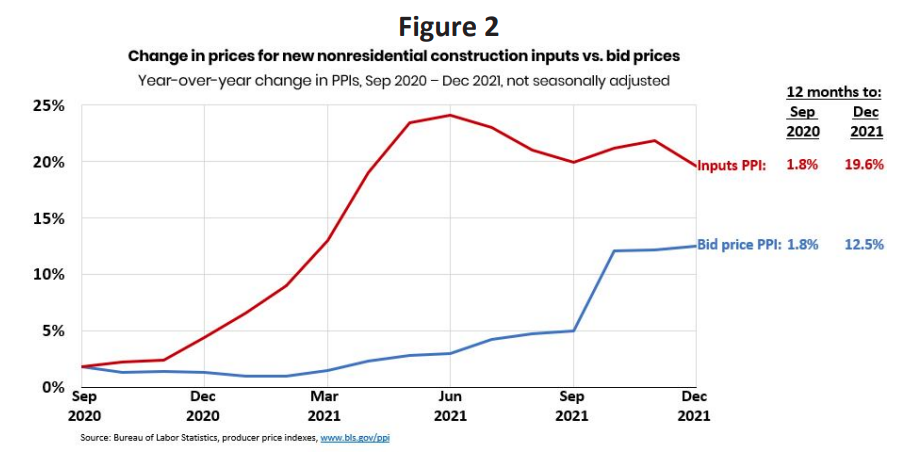 AGC posted the February 2022 edition of its Construction Inflation Alert on Wednesday. The document is intended to inform owners, officials, and others about recent developments affecting materials costs, supply chains, and worker wages and availability.
AGC posted the February 2022 edition of its Construction Inflation Alert on Wednesday. The document is intended to inform owners, officials, and others about recent developments affecting materials costs, supply chains, and worker wages and availability.
Prices and availability for construction inputs are showing varied trends. The price for hot-rolled coil has fallen 39% in the past five months, returning to the year-ago level, Steel Market Update reported on Wednesday. Lead times also fell sharply, implying further reductions. How soon this will translate into lower prices or lead times for construction steel products is unclear, however. The American Chemistry Council reported today that supplies of chlorine and ethylene, which are ingredients for numerous construction plastics, continue to be tight, with some lingering reduced capacity resulting from damage caused in Louisiana by Hurricane Ida last August. Reportedly, some rail and truck chemical shipments get bumped in favor of nonhazardous materials shipments that have fewer requirements for shippers to deal with. Regarding titanium dioxide (TiO2), the whitening agent for paints and other coatings, leading supplier Chemours Co. reported today, “Ore constraints continuing into 2022, alongside raw material inflation, logistics challenges, and broader customer supply chain issues.” The average retail price of on-highway diesel fuel climbed 10 cents per gallon this week to $3.95, up $1.15 (41%) from a year ago and the highest since 2014, the Energy Information Administration reported on Monday.
There are signs that portions of the supply chain are improving but it is too early to say if the improvement will last. “The number of container ships queuing to enter the ports of Los Angeles and Long Beach declined to 78 vessels on Tuesday, down from the peak of 109 ships reached a month earlier, according to the Marine Exchange of Southern California,” the Wall Street Journal reported today. “Port officials say it is unclear whether the decline, which has accelerated over the past week following a surge shortly before and after the December holidays, is the beginning of a trend or a temporary respite because of factory slowdowns in Asia for the Lunar New Year holiday that began February 1….Although the ship backup is the smallest it has been since November 11, congestion remains severe by historical standards. Container ships are waiting an average of 18 days to unload at the Port of Los Angeles, the busiest of the neighboring gateways. Before the pandemic, it was unusual for ships to have to wait for a berth….Specialists at Denmark-based marine consulting firm Sea-Intelligence ApS say that based on previous ship backups, it could take eight or nine months to clear the ship backlog once operations run more efficiently. They are yet to see clear signs of progress.”

“The Dodge Momentum Index declined 7% in January to a four-month low,” Dodge Construction Network reported on Monday. The index “is a monthly measure of the initial report for nonresidential building projects in planning, which have been shown to lead construction spending for nonresidential buildings by a full year. In January commercial planning fell 9% and institutional planning slipped 1%. The Dodge Momentum Index had a stellar 2021, rising 23% from 2020 and reaching levels not seen in nearly 14 years. The recent string of declines, however, may be blamed on rising costs, logistical problems and shortages of skilled labor. Still, even as it has decreased, the dollar value of projects in planning remains exceptionally strong, especially for education, warehouse and healthcare projects.” The commercial sub-index dipped 2% from January 2021, while the institutional sub-index soared 50%.
“Economic activity in the services sector grew in January for the 20th month in a row,” the Institute for Supply Management reported on February 3. Construction is among 15 out of 18 services sectors that reported growth in January, 18 that reported paying higher prices for materials and services, 17 that reported slower supplier deliveries, 11 that reported an increase in order backlogs, 10 that reported an increase in orders, and 5 that reported increases in employment. Items reported up in price that are significant for construction included aluminum products (2 months in a row); construction labor (6 months) and contractors (7 months); copper products (PPE, 2 months); diesel fuel (14 months); heating, ventilation and air conditioning (HVAC) equipment; lumber; personal protection equipment (2 months); polyvinyl chloride (PVC) products (5 months); and steel products (13 months). Items listed in short supply included appliances (2 months), construction contractors (5 months) and subcontractors (6 months), flexible duct, HVAC equipment, PPE--masks and gloves, PVC pipe and fittings, and steel products (5 months).
Construction workers continue to lag other occupations in covid vaccination rates. Among respondents to an ongoing survey of Facebook users analyzed by the Delphi Group of Carnegie Mellon University, only 56% of respondents who identified as being in construction occupations reported they were vaccinated, compared to 83% for all other occupations during the week beginning January 23, the construction safety and health research organization CPWR reported today. Conversely, 41% of construction respondents reported “vaccine hesitancy,” nearly triple the hesitancy rate for other occupations.
“Between April 2021 and December 2021, total state tax revenues increased 26.3% in nominal terms compared to the same period one year earlier, Lucy Dadayan of the Urban Institute reported on Wednesday. “Growth was strong among all major sources of tax revenue: personal income taxes increased 21.0%, corporate income taxes increased 62.7%, and sales tax revenues increased 23.7%. Most states are forecasting continued growth in state tax revenues for the rest of [fiscal year (FY)] 2022 as well as into FY 2023.” These gains should enable states to increase funding for construction. State and local construction spending put in place declined 2.8% from 2020 to 2021, the Census Bureau reported on February 1.


